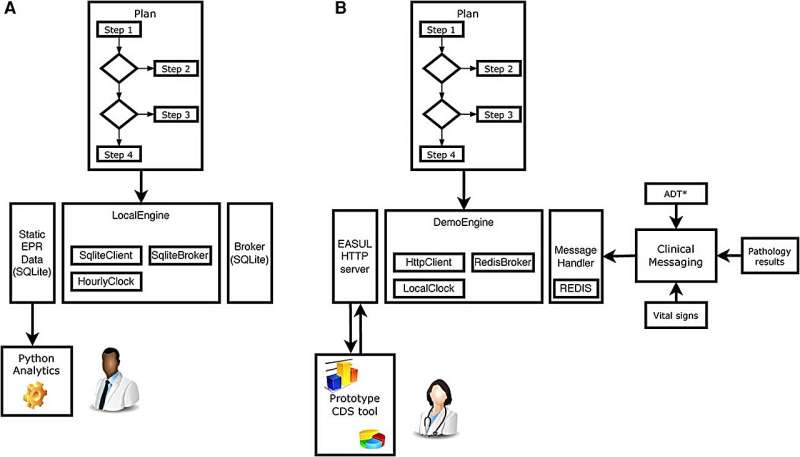This article has been reviewed according to Science X's editorial process and policies. Editors have highlighted the following attributes while ensuring the content's credibility:
fact-checked
proofread
Software created from 'building blocks' could incorporate artificial intelligence, supporting medical staff

New "building-block" approaches to the creation of digital tools that include data and artificial intelligence could play a key role in improving the running of hospital wards and disease management, according to the findings of new research.
The study, by Dr. Robert Free at the National Institute for Health and Care Research (NIHR) Leicester Biomedical Research Centre (BRC), suggests that using a package of digital 'building-blocks' to create clinical decision support programs would make it possible to create digital tools that help medical staff prioritize patient care and workloads more effectively.
The study, published in Frontiers in Digital Health outlines how a system of computer software building blocks, developed by the research team, could enable faster more effective disease management protocols for handling local admissions of community acquired pneumonia (CAP). It also explores how this approach could be applied across health care more generally.
Their building block system, Embeddable AI and State-based Understandable Logic (EASUL) can use historic data, electronic medical records and include algorithms to develop digital platforms that accommodate different stages of clinical care for patients and allow medical staff to examine this—including likely patient outcomes.
In the study, researchers modeled scenarios using existing patient data and consultations with teams of Specialist Pneumonia Intervention Nurses (SPIN) to test how a program built using EASUL could be used to help clinicians manage those admitted with CAP. The program was given the data of 52,471 adults admitted between April and June 2022, 630 of whom were diagnosed with CAP. The advice and information generated by the program was compared with the clinical risk assessments given by the SPIN team.
When tallied, EASUL risk assessment matched with the SPIN teams 49.4 % of the time. EASUL never rated any patient as low risk who had been rated as high risk by the clinical team. EASUL also identified 57 cases which, when reviewed by researchers, should have been rated as high risk but only recorded as low or moderate by clinical staff.
The paper's authors stressed that the differences were likely due to individual clinical judgment where extensive risk assessment was not considered as clinically appropriate. Due to a lack of available information in the existing patient data it was not possible to include this element in the evaluation.
The researchers behind EASUL also believe another of its potential advantages is its flexible design. It allows for "on the fly data," collected as treatment and research is carried out, to be easily included in the system. It has also been designed in a format that can potentially be integrated with existing digital clinical decision support systems.
As a result, EASUL could be adjusted to suit the needs of a variety of clinical settings. It is also designed to automatically adjust its calculation in case of missing data, meaning it could provide robust and relevant information to clinical staff in a variety of different situations.
Dr. Robert Free, Lecturer in Health Data Science and principal investigator on the study said, "This is a very exciting development. Our proof-of-concept clinical system allowed us to demonstrate how our building block approach could deal with algorithms of varying complexities across the patient's care. Using EASUL we were able to include both simple risk scores and a pre-existing artificial intelligence model in a real-time data-driven workflow and then present it to clinicians—helping them make decisions about patients."
Dr. Pranabhashis Haldar, a Senior Clinical Lecturer in the NIHR Leicester BRC's Respiratory Theme, and a contributor to the study, added "The flexible nature of our approach means it can be extended to support different data types, adaptive workflows including advanced artificial intelligence models and potentially mobile apps. Additionally, it could also be used to support patient directed health care actions, such as remote monitoring."
Dr. Free concluded, "We believe that EASUL and similar approaches are important steps for making better use of health data from multiple sources and would help to strengthen trust and accountability in complex artificial intelligence enabled clinical decision support. However, we recognize that further research is needed before this can be rolled out into active clinical settings."
More information: Robert C. Free et al, A data-driven framework for clinical decision support applied to pneumonia management, Frontiers in Digital Health (2023). DOI: 10.3389/fdgth.2023.1237146




















